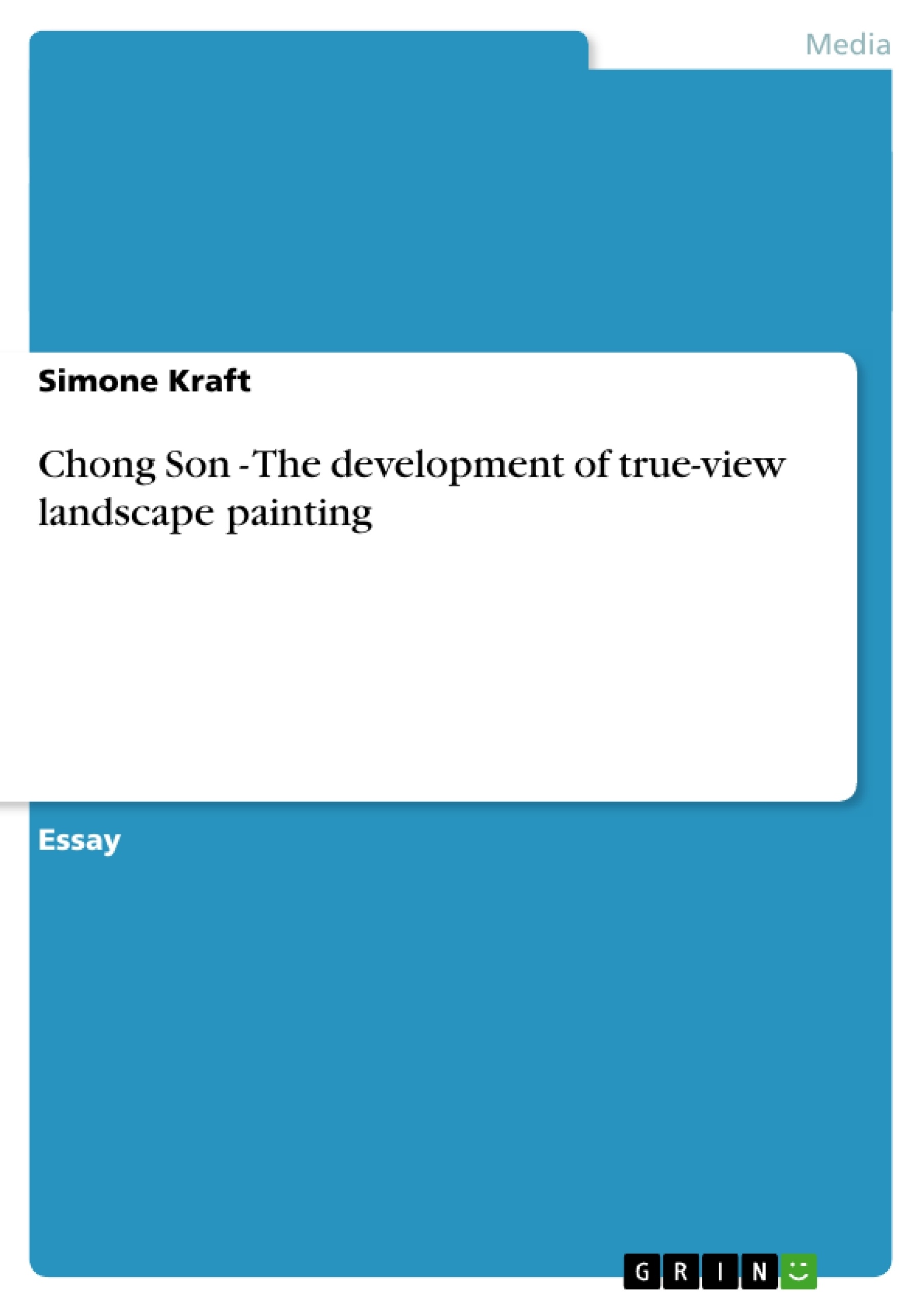In the Chosŏn period (1392-1910), Korean landscape painting flourished. Traditionally strongly bound to a Chinese paradigm, the Korean masters of painting sought to give their works distinctive peculiarities. Especially from the middle of Chosŏn period on, strong tendencies towards “Koreanization” emerged comprising not only arts but all sectors of life. Initially, painting developed slightly different characteristics still within the scope of the paramount Chinese arts such as bolder outlines and coarser brushwork (Pratt, 1995: 43). The painter Chŏng Sŏn (1676-1759) eventually heralded the turn to a typical Korean style of landscape painting, the so-called “chin’gyŏng (sansu)”, true-view landscape painting. Reaching its peak in the following eighteenth century, this genre depicts the beauty of real Korean countryside using a certain technique which bears distinct features, even though still being geared to Chinese example.
Contents
1) Introduction
2) Short outline: Landscape Painting
3) Chŏng Sŏn’s development of a distinctive style
4) Conclusion: Chin’gyŏng sansu – True-View Landscape Painting
5) Literature
1) Introduction
In the Chosŏn period (1392-1910), Korean landscape painting flourished. Traditionally strongly bound to a Chinese paradigm, the Korean masters of painting sought to give their works distinctive peculiarities. Especially from the middle of Chosŏn period on, strong tendencies towards “Koreanization” emerged comprising not only arts but all sectors of life. Initially, painting developed slightly different characteristics still within the scope of the paramount Chinese arts such as bolder outlines and coarser brushwork (Pratt, 1995: 43). The painter Chŏng Sŏn (1676-1759) eventually heralded the turn to a typical Korean style of landscape painting, the so-called “chin’gyŏng (sansu)”, true-view landscape painting. Reaching its peak in the following eighteenth century, this genre depicts the beauty of real Korean countryside using a certain technique which bears distinct features, even though still being geared to Chinese example.
It may be astonishing to see such an old and highly developed culture as the Korean culture establishing cultural autonomy only in the 17th/18th centuries – rather late regarding the long artistic traditions in Korea (Whitfield, Pak, 1984: 182). To comprehend this it is important to consider both the concept of artistic mastership and the political circumstances.
The Asian painter traditionally learned through copying the works of renowned masters (cf. Pratt, 1995: 40). Underlying this technique of imitation, however, is a certain notion which differs from the one of European painters, for instance. While the European painter studied the old masters to practise his own abilities, the Asian artist estimated the older works as examples of artistic perfection which he himself could only try to approach to by imitating it. The better one mimicked the artwork, the more valuable one’s own art was. Developing an individual style was not significant.[1] The idea of forgery did not exist. Emulating famous pictures was “the sincerest form of flattery” (Pratt, 1995: 40).
The Koreans of the first half of the Chosŏn period maintained close connections to the Chinese Ming court which they regarded as the superior cultural example (cf. Yi, 1998, 340 et seq.). It might appear paradoxical that it was just this strong orientation to the neighbouring state which finally led to the establishment of Korean self-consciousness as result of major changes in China. In 1644, the Chinese ruling dynasty, the Ming, were overthrown by the Manchu. Korea, which thought itself as culturally highly developed as it had been closely bound to Ming China so far, thus lost this intellectual and cultural ideal (cf. Yi, 1998: 340). While considering the Manchu’s system less civilised, Koreans stopped to import Chinese influences but considered themselves as heirs of Ming China and thus of the Han Chinese tradition. It referred to itself as “minor China” (Yi, 1998: 340). Besides, the Chinese cultural activity stagnated in these days (Whitfield, Pak, 1984: 185). Thus the cultural superiority got shifted to another centre. Since the external model had vanished Korean intellectual awareness turned to the interior – to its own traditional works of art as well as to its own history. These new thoughts got voiced by the Sirhak movement, the School of Practical Learning. These scholars tried to disperse the new understanding of their country’s history and culture with various publications on Korean history, literature, language and geography (Yi, 1998: 341). Their research finally led them to rejection of the “minor China” concept and hence into opposition of the conservative notions. Nevertheless, both point of views resulted in a new effort and interest in Korea’s own traditions and culture.
The interaction of all these eminent changes eventually led to both the innovations which peaked in the art of Chŏng Sŏn and the effective genre of true-view landscape painting which he founded.
[...]
[1] This does not refer to the example of calligraphy where style reflects individual character.
- Arbeit zitieren
- M. A. Simone Kraft (Autor:in), 2004, Chong Son - The development of true-view landscape painting, München, GRIN Verlag, https://www.grin.com/document/76723
-

-

-

-
Laden Sie Ihre eigenen Arbeiten hoch! Geld verdienen und iPhone X gewinnen. -

-
Laden Sie Ihre eigenen Arbeiten hoch! Geld verdienen und iPhone X gewinnen. -

-
Laden Sie Ihre eigenen Arbeiten hoch! Geld verdienen und iPhone X gewinnen. -

-
Laden Sie Ihre eigenen Arbeiten hoch! Geld verdienen und iPhone X gewinnen. -

-
Laden Sie Ihre eigenen Arbeiten hoch! Geld verdienen und iPhone X gewinnen.

